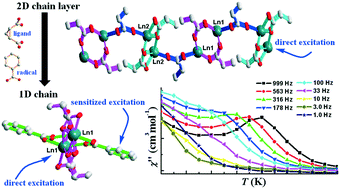2D chain layer versus 1D chain: rigid aromatic benzoate disassembling flexible alicyclic dicarboxylate-based lanthanide coordination polymers with enhanced photoluminescence and characteristic single-molecule magnet behavior†
Abstract
Aiming to study the photoluminescence and magnetic evolution by modulating the coordination environment, two series of lanthanide coordination polymers (LCPs) [Ln2(μ3-cpdc)3(H2O)3]n (cpdc-Ln) and [Ln(μ3-cpdc)(μ2-bc)(H2O)]n (cpdc-bc-Ln) (Ln = Eu, Tb and Dy; cpdc = cis-1,2-cyclopropane dicarboxylate; bc = benzoate) have been successfully synthesized and structurally characterized for the first time. Almost identical synthetic conditions confirm that terminal grafting of an aromatic benzoate activator on cpdc-Ln promotes disassembly of their 2D chain layer structures into isolated 1D chain motifs present in cpdc-bc-Ln. Besides the structural response, the responsive photoluminescence and magnetic evolution of cpdc-Ln and cpdc-bc-Ln are also comparatively discussed. The solid state photoluminescence properties of cpdc-Ln and cpdc-bc-Ln (Ln = Eu, Tb and Dy) are comparatively investigated under direct and sensitized excitation conditions. Since the rigid aromatic benzoate activator can play the role of an antenna and sensitize the luminescence of lanthanide ions, the excitation and emission spectra, fluorescence lifetime and absolute quantum yield results show that cpdc-bc-Ln have highly efficient photoluminescence compared with the corresponding cpdc-Ln. In particular, the absolute quantum yield for cpdc-bc-Tb is close to 100% upon excitation at 287 nm, suggesting completely effective energy transfer from benzoate to Tb3+ centers. Possible luminescence mechanisms concerning energy transfer are also proposed. Magnetic studies reveal the ferromagnetic coupling existing in cpdc-Dy and cpdc-bc-Dy, and only cpdc-bc-Dy with discrete 1D chain characteristics displays noticeable frequency dependence of magnetic susceptibilities and presents obvious out-of-phase signals under a 2 kOe dc field, indicating the field-induced single molecule magnet (SMM) behavior with an energy barrier of 55.07 K. The studies demonstrate that the synthetic strategy of terminal grafting aromatic groups on alicyclic multicarboxylate-based LCPs can be used to design functional materials with highly efficient photoluminescence and characteristic SMM behavior.



 Please wait while we load your content...
Please wait while we load your content...